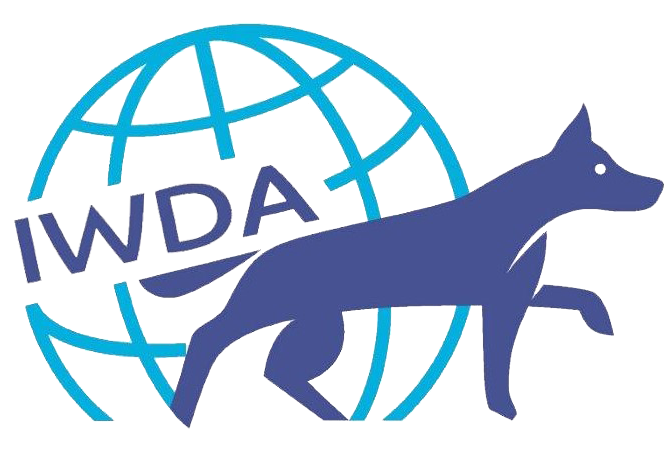Search for working dog conference recordings, articles on health, breeding, socialization and organizational management, webinar recordings and more.
Old Conference Archive Page | View all IWDC 2023 Recordings | View all Breeder's Workshop Colorado Recordings
-
Organization Management
-
Canine Resources
-
- Articles coming soon
-
-
- Emotional Conflict During Socialization
- What is environmental enrichment?
- Distance, Distraction and Duration
- Developing Foundational Skills
- Luring, Marking & Giving Food
- 5 Steps to Progressing Skills
- Dog-Human Relationship Skills
- Utilizing Volunteers
- Biosecurity
- Biosecurity protocol documents
- Example Socialization Schedule
- Puppy Socialization Tracker
- Crate Training
- Managing Inappropriate Interactions between littermates
- Preventing and Fixing Door Dashing
- Follow Me: Video
- Bath Progression: Video
- Intro to New Environments: Video
- Motor Development: Video
- Novel Objects: Video
- Novel Sounds: Video
- Trolley Ride: Video
- Wearing Things/Coat Desensitization: Video
- Carrying Puppies Safely
- Safely Using Stairs: Video
- Puppy Confidence Course
- Socialization Ideas Gallery
- Weighing Puppies: Video
- Birth of a Puppy: Video
- First Time Outside the Den: Video
- First time Exploring the Garden: Video
- Exploring the garden in the dark: Video
- Include puppies in the daily work routine: video
- Collar Habituation: video
- Exploring a wobble board
- Exploring the world - unfamiliar surroundings
- Walking around the grounds
- Socialization opportunities in daily life
- Walk in the woods
- Exploring the world
- Free time for moms
- Explore the stairs and garden
- Explore the puppy garden
- Show Remaining Articles ( 28 ) Collapse Articles
-
- Articles coming soon
-
Education
-
-
- A Behavioral Questionnaire for Selection and Study of Odor Detection Dogs - Presented by Cynthia Otto
- Audeamus PTSD Service Dogs, ACAC Accredited Peer-Support Model for Veterans and First Responders - Presented by Chris Lohnes and Grace Rath
- Audeamus Service Dogs and University of Saskatchewan Research Partnership and Outcomes - Presented by Chris Lohnes & Grace Rath
- Building a Purpose Bred Breeding Program - Presented by Allison Peltier and Rachel Goldammer
- Core body temperature and activity level changes during work and exercise in patrol dogs of the Queensland Police Service - Presented by Jayne McGhie
- Detection of Heterobasidion parviporum scent samples in indoors scent discrimination test by trained volunteer dog-handler teams - Presented by Heli Väätäjä
- Development of a Tool to Aid in the Selection and Pairing of Breeders based on Behavioral Traits - Presented by Jordan Smith
- Early Detection of Heat Stress in Working Dogs - Presented by Andrea L. Henderson
- Effects on behavior and physiology of handling style during veterinary visits - Presented by Karen Overall
- Field cooling for exertional hyperthermia - Presented by Cynthia Otto
- From Anxious to Resilient: The Role of Dynamic Interactive Engagement in Shaping Military Working Dogs - Presented by Melanie Uhde
- Genetic Resources to Improve Dog Health - Presented by Angela Hughes (Royal Canin)
- Genomic research in the Working Dog Field: Combating Canine Cancer through Collaboration and Comparative Oncology Research - Presented by Frances L. Chen
- Handler Perceived Risks to Operational Detection and Patrol Police Dogs - Presented by Jayne McGhie
- Improving Trauma Patient Care - Presented by Kelly Hall
- Neuromuscular Balance Training in Working Dogs - Presented by Andrea L. Henderson
- Occupational Risks and Specialized Veterinary Care for Working Dogs - Presented by Cynthia Otto
- Putting working dog research into practice: development of science-based guidance notes - Presented by Fiona Williams
- Rating of Perceived Exertion in Working Dogs - Presented by Andrea L. Henderson
- Real-world experience with liquid biopsy testing for cancer detection in working dogs - Presented by Jill Rafalko
- Specialty Practice Behavioral Problems and Outcomes in Companion Dogs - Implications for Working Canines - Presented by Walt Burghardt
- Start of life – Feeding during pregnancy and lactation to increase reproductive success - presented by Angela Hughes (Royal Canin)
- Teaching Collar Yielding as a Foundation Behavior - Presented by Patrick Glines
- The Doberman Diversity Project: a Citizen Science approach to breed improvement - Presented by Sophie Liu
- The effect of inhibitory control, arousal, and affective state in Military Working Dogs Performance - Presented by Astrid Concha
- The effect of training aid volume on odor generalization in detection of chronic wasting disease in deer - Presented by Mallikarjun and Wilson & Cindy Otto
- The Many Dogs Project: A Big Team Canine Science Effort - Presented by Sarah-Elizabeth Byosiere
- Transformative Power of Freedom of Choice in Changing Behavior - Presented by Marty G. Roache
- Turning a Critical Eye on an Established Breeding Program to Improve End Results Using IWDR - Presented by Natalie Ergler and Rachel Goldammer
- U.S. Military Working Dog Welfare - Presented by Desireé Broach
- What is the future of Biological Detection Canines? - Presented by Heather Junqueira & Ken Furton
- Working dog memory and canine gut microbiome - Presented by Xu Wang
- Show Remaining Articles ( 17 ) Collapse Articles
-
- Breeding Healthy Dogs - Presented by Madeline Zimmermann
- Choosing What to Breed For - Presented by Madeline Zimmermann
- Gaiting - with Doug & Colton Johnson
- Genetic Merit Selection - Presented by Madeline Zimmermann
- Improving Behavior - Presented by Jane Russenberger & Dr. David Roberts
- IWDR: Storing your Data - Presented by Rachel Goldammer
- Keep Data on Everything! - Presented by Rachel Goldammer
- Long-Term Colony Management: Balancing genetic improvement breeding for the whole dog - Presented by Dr. Eldin Leighton
- Power of Numbers: IWDR Functions - Presented by Rachel Goldammer
- Producing Puppies - Presented by Dr. Fiona Hollinshead and Dr. Greg Burns
- Puppy Socialization - Presented by Jane Russenberger
- Puppy Socialization for Handling - presented by Doug & Colton Johnson
- Reading Dog Behavior/Emotional States - Presented by Dr. Karen Overall
- Whelping and Neonatal Care - Presented by Dr. Fiona Hollinshead and Dr. Greg Burns
-
- "All about the boy" - Semen Collection and Analysis - presentation by Dr. Fiona Hollinshead
- All about the brood - presentation by Dr. Greg Burns
- Behavior Checklist (BCL) Workshop - with Helen West
- Behavioral scoring in Puppy Raising - presentation by Helen West
- Brood and Whelping Concerns - presentation by Dr Greg Burns
- Calculating Differential Risk of Osteoarthritis in Dogs with Low vs High Hip Scores - presentation by Dr Tom Lewis
- Cardiac diseases - presentation by Dr Kevin Conrad (absent); presented by Dr. Kyle Quigley
- Conditioning Program for Dogs Coming In For Training - presentation by Dr Kevin Conrad (via zoom)
- Critical periods of socialization and impact on temperament of the dog - presentation by Jane Russenberger
- Does early potty training affect indiscriminate relieving? - presentation by Dr Lynna Feng
- Dog behavior is in the eye of the beholder - presentation by Joke Monteny
- Entropion - presentation by Jenna Bullis
- Feeding for Breeding Success - presentation by Dr. Emmanuel Fontaine
- Gait and Structure Evaluation for Guide Dogs - presentation by Peggy Gibbon and Dr Katy Evans
- GDBart Puppy Test - presentation by Helen West
- Healthy microbiome and faecal transplants - presentation by Dr Kevin Conrad (absent); presented by Dr Caroline Moeser
- Hip and elbow assessments - with Dr Bart Broeckx
- How to make breeding decisions on traits without EBVs - presentation by Madeline Zimmermann
- How to use estimated breeding values successfully - presentation by Madeline Zimmermann
- Improving behavior with EBVs: Body sensitivity, Noise Fear, Inhibited by Stress, Activated by Stress, Excitable - presentation by Jane Russenberger
- Improving health using EBVs: Elbow, Skin and Mast cell tumours - presentation by Madeline Zimmermann
- Is it really epilepsy? - with Dr Bob Proesmans & Dr Caroline Moeser
- Neonatal Care - presentation by Dr Emmanuel Fontaine
- Reproductive Trends and Cryogenic Insights from Guiding Eyes - presentation by Clover Williams
- Selecting Reproductively Healthy Dogs - presentation by Dr Emmanuel Fontaine
- Skin allergies - with Dr Caroline Moeser
- Stargardt's disease in Labrador retrievers - with Dr Katy Evans
- Strategies for genetic diversity - presentation by Jackie Clark and Dr Bart Broeckx
- Superficial Digital Flexor Tendon Avulsion - presentation by Dr Caroline Moeser
- The art of insemination - presentation by Dr. Fiona Hollinshead
- The Overall Selection Index - presentation by Dr Eldin Leighton
- What influences semen quality? - presentation by Dr. Tom Lewis
- Show Remaining Articles ( 17 ) Collapse Articles
-
- A detailed evaluation of Spotted Lanternfly (Lycorma delicatula) detection dog training and performance - Presented by Edgar O. Aviles-Rosa
- A novel method for the detection of Japanese knotweed (Reynoutria japonica) using specially trained canines - Presented by Kat Janczur
- AKC Detection Dog Task Force Program: Working with AKC Breeders to Improve Breeding & Availability of Explosives Detection Dogs - Presented by S Goffe
- Assessing working dog fitness with the Penn Vet Working Dog Center Fit To Work program - Presented by Brian Farr
- Assessment of the Agreement between Fosters and Trainers Evaluating Behavior with the C-BARQ and Behavior Checklist presented by Elizabeth Hare
- Behaviour Assessment and IWDR - Presented by Dr Jane Russenberger
- Breeding Strategies and Advanced Reproductive Techniques to Optimize Production of Improved Generations of Specialized Canines at Three major working dog breeding programs in New Zealand - presented by Dr Fiona Hollinshead
- Development and heritability of cognitive traits in Canine Companions dogs presented by Emily Bray
- Digital innovation for working dogs - Presented by Dr Mia Cobb
- Discrimination between SARS-CoV-2 infection and other viral respiratory infections by working dogs - Presented by Nele ten Hagen
- Effect of impulsivity and core effect on training performance in dual purpose military working dogs - Presented by Astrid Concha
- Epilepsy in working dogs - Presented by Prof Holger Volk
- Estimated Breeding Values in IWDR - Presented by Dr Eldin Leighton
- Examining the Role of Significant Others in Canine Welfare within the Context of Veterans Working with Service Dogs - Presented by Linzi Williamson
- Explosive detection canine operational requirements and performance degradation: expert perspectives - Presented by Brian Farr
- Hot Topics in Working Dog Care - Presented by Dr B. Pierce & Dr K. Mann
- Implementation of a plan to decrease arousal and increase motivation - Presented by Robert Dougherty Jr and Alena Heyer
- Improving behavior monitoring within a working dog program - Presented by Becky Hunt
- Incidence of enteric pathogens versus presence of gastrointestinal symptoms in a working dog training facility - Presented by Dr Nicola Cotton
- Investigation of tail injury at Lackland Air Force Base Training Kennels for Military Working Dogs - Presented by Marty G. Roache & Karen L. Overall
- Learning to Smell: Impacts of Training and Experience on Detection Dog Performance - Presented by Nathaniel Hall
- Lecture on Generalization in Detection Work - Presented by Hans Ebbers
- Liquid biopsy screening for early cancer detection in working dogs - Presented by Katherine M. Lytle, DVM, MPH, MS
- Military Working Dog Aggression and Welfare - Presented by Desiree Broach
- Multimodal characterization of detection dog suitability: Combining behavioral, cognitive, and neurological measures for enhancing selection - Presented by Lucia Lazarowski
- Overview of the IWDR for Working Dog Organizations - Presented by Dr Eldin Leighton
- Pandemic or pandemonium? Creating standards for medical detection dogs - Presented by Dr Cynthia Otto
- Penn Vet Working Dog Center Fit To Work program foundational fitness development and training - Presented by Meghan Ramos
- Preliminary Accuracy of COVID-19 odor detection by canines - Presented by Kenneth G. Furton
- Prevalence of Canine Degenerative Myelopathy SOD-1 Mutation in Working Shepherd Dogs across Australia and New Zealand - Presented by Jayne McGhie
- Scent dog identification of SARS-CoV-2-infections- a double blind study - Presented by Esther Schalke
- Solving cold-cases: Dogs can match human scents collected several years apart - Presented by Margot Perez
- The Application / Practical Implementation Pro/Cons of Covid-19 Olfactory Detection Dogs - Presented by Prof D Grandjean
- The Domestic Breeding Consortium: Odor Detection Canine Selection, Breeding, and Early Training Techniques - Presented by Karen Meidenbauer
- The effect of maternal style on later puppy behavior in Canine Companions dogs - Presented by Brenda Kennedy
- The use of historical health records at The Seeing Eye in genome-wide association studies for canine health traits presented by Katy M. Evans
- Training with Varying Odor Concentrations: Implications for Odor Detection Thresholds in Canines - Presented by Mallory DeChant
- Transitioning a Therapy Dog Program Online: What's In It For the Dog? - Presented by Ben Carey
- Using IWDR's Advanced Tools to Improve HeaLth and Behaviour - Presented by Dr Eldin Leighton
- Using Single-Step Genomic BLUP to Compute Genomic Enhanced Breeding values for Self-Modulation in Working Dogs presented by Molly Riser
- Using trained dogs and organic semi-conducting sensors to identify asymptomatic and mild SARS-CoV-2 infections - Presented by Dr Claire Guest and Prof James Logan
- Working Dog Welfare: Where are we now and where are we going? - Presented by Dr Mia Cobb
- Show Remaining Articles ( 27 ) Collapse Articles
-
- A canine thermal model for mitigation of heat strain in working dogs - Presented by C. O'Brien
- Building a better detector dog: Lessons learned and (many) questions remaining to be explored in Auburn University’s 19 years of detector dog production - Presented by P. Waggoner, PhD
- From Puppyhood to Adolescence: Longitudinal Cognition Study at Canine Companions for Independence - Presented by K. Levy
- Genome-wide association studies to identify loci and variants associated with behavioral traits in dogs - Presented by V.D. Marinescu, PhD
- Hyper-reactivity in military working dogs: a report of two cases - Presented by O. Soares, DVM, PhD
- Measuring, and determining factors affecting performance of glycemic alert dogs - Presentation by N. Rooney, PhD
- Neuromotor development in puppies: implications for training and fitness - Presented by B. Pierce, DVM, MS, DACVIM, DACVP, DACVSMR
- Odour generalisation – theory and practice - Presented by A. Schoon, PhD
- Putting working dog research into practice: development of science-based guidance notes - Presented by V. Ratcliffe, PhD
- Referential focus - pet & working dogs - Presented by K. Overall, MA, VMD, PhD, DACVB
- Statistics for working dogs – how do you know if your test/assessments are better than a coin toss? - Presented by A. Dunham, PhD
- Temperament and EBV - Presented by Erling Strandberg, PhD, SKK
- Testing dogs for behaviour in Sweden: Canine temperament - assessment and heritability & How you assess temperament - presented by Åke Hedhammar DVM, PhD & Kenth Svartberg, PhD
- The chemistry of odor: How understanding odor can foster a better detector - Presented by L. De Greeff, PhD
- The opioid crisis and working dogs - Presented by C. Otto, DVM, PhD, DAVCECC
- What helps and what hinders assistance dog/puppy raising practices? - Presented by Doc Loc Mai (Jimmy)
- Working Dog Centre: Working hard for working dogs - Presented by W. Baltzer, DVM, PhD
- Show Remaining Articles ( 2 ) Collapse Articles
-
- BCL Workshop with Rachel Goldammer
- Anchor at Sea: Breeding for the Whole Dog - presented by Dr Eldin Leighton
- Picking and Managing Breeder Candidates - presented by Madeline Zimmermann
- GDB Whelping Box Fleece and Hip Dysplasia Study - presented by Dr. Kris Gonzales and Lauren Holtz
- The Importance of Longitudinal Behavioral Data - presented by Dr. Dave Roberts (NCSU), Jane Russenberger
- Lifetime Health Data: Critical for Your Decision-Making - presented by Jane Russenberger
- Fighting Cancer with Genomics: Developing Breeding Values to Reduce Hemangiosarcoma Risk and Unlocking DNA insights - presented by Frances Chen
- Discovery of Early On-Set PRA - presented by Glenna Fiddyment
- Suspected autosomal recessive primary ciliary dyskinesia in a colony of Labrador Retriever guide dogs - presented by Katy Evans
- Small Litter Whelp Protocol and Utilizing Best Practices in a 24-Hour Whelping Facility - presented by Kristine Gonzales
- Genetic and genomic investigations into canine atopic dermatitis - presented by Dr Tom Lewis
- Puppy Socialization Application with limited Staff and Resources - presented by Natalie Ergler, Guide Dogs of America
- Low-Pass Whole Genome Sequencing: Equipping the Working Dog Field with Next-Generation Genetic Tools Through Research Partnerships - presented by Frances Chen
- Smart Collar Project - presented by Dr. Dave Roberts
- Canine Genetics And Genomics: A Primer - presented by Dr Eldin Leighton
- Harnessing the Power of Longitudinal Data in IBC: Insights, Challenges, and Applications - presented by Dana Hunter
- Repro Techniques Demonstration and Discussion: Examination of the male - presented by Dr Gary England
- Repro Techniques Demonstration and Discussion: Examination of the female – presented by Dr Gary England
- Show Remaining Articles ( 3 ) Collapse Articles
-
- Unifying the Canine Detection Community: The Impact of Standard Development on Global Practices - Presented by Paola A. Prada-Tiedemann
- Utilizing scent detection dogs in the early detection of Ips typographus damages - Presented by Reetta Kangaslampi & Dr Olli-Pekka Tikkanen
- The Detection of Oil Under Ice and Water by Oil Detection Canines - Presented by Paul Bunker
- Quality Management and Deployment of Mine Detection Dogs: NPA Approach - Presented by Kenan Muftic
- Breeding on a (Shoestring) Budget - Presented by Patrick Glines
- Remote detection - Presented by Jens Frank
- From Laboratory Insights to Operational Efficiency - Presented by Joshua Araujo
- Foundational Skills for Greater Success in the Working Dog - Presented by Jane Madigan
- What olfactory psychophysics and ethology can contribute to work with sniffer dogs - Presented by Simon Gadbois
- The impact of distraction training on dogs’ learning and task performance - Presented by Carla Hart
- Training a cadaver detection dog - Presented by Hans Ebbers & Marco Muglia
- Vapor Diffusion in Soil: Simulated Explosive Burials and Canine Trials - Presented by Emma Calabrese
- Optimising Police Dog Breeding and Development for Operational Performance - Presented by Scott Bruce
- Building Successful Partnerships with Private Breeders for Working Dog Programs - Presented by Laura Edwards
- Lessons learned from training dogs to detect plants - Presented by Kat Janczur
- Identifying when early puppy behaviors deviate from ‘normal’ and implications for development of behavioral pathology - Presented by Karen Overall
- Collaborative canine genomics: developing the next generation of genetic selection tools in working dogs - Presented by Frances Chen
- Genomic estimated breeding values on health and behavior traits to inform breeding and management of working dogs - Presented by Heather Huson
- Overview of maintaining genetic diversity - effective population size - practical applications in a breeding program - Presented by Tom Lewis
- Human Animal Bond- Contact-Free Simultaneous Sensing of Human Heart Rate and Canine Breathing Rate for Animal Assisted Interactions - Presented by Dave Roberts
- Dietary Management of Working Dogs: More than Just Calories - Presented by Erin Perry
- UK ISAR Dogs in the 2023 Türkiye-Syria Earthquake Response - Presented by Lyndsay Sielski
- Understanding and meeting the welfare needs of working dogs - Presented by Sam Gaines
- Decoding Disease Detection - Presented by Claire Guest
- Mind the Gap: Human Perceptions, Canine Preferences, and the Importance of Welfare Assurance in Working Dog Programs - Presented by Mia Cobb
- Stress travels down the lead but also through the air - Presented by Nicola Rooney
- Suspected autosomal recessive primary ciliary dyskinesia in a colony of Labrador Retriever guide dogs - Presented by Katy Evans
- Nutritional Needs of Working Dogs - Presented by Caroline Burke (Royal Canin)
- An examination of the latest research relating to kennelled dog welfare - Presented by Dr Jenna Kiddie
- Can a synbiotic provided to puppies affect the incidence of diarrhoea during the transition from nest to puppy raiser? - Presented by Madeleine Goumas
- MWD Functional Assessment - Preserving the Fighting Force - presented by Andrea Henderson
- From Can't Get Right to Law Enforcement K9 - Daniel's Story - presented by Marty Roache & Angel Landrau
- Multi-modal Treatment of Diarrhoea and the Importance of the Microbiome - Presented by Michelle Van Lienden
- Show Remaining Articles ( 18 ) Collapse Articles
-
-
-
- Veterinary Genetics with Dr Angela Hughes
- Optimizing Volunteers for Early Socialization Success with Liz Rote
- Inbreeding in Working Dog Colonies with Dr Eldin Leighton
- Partners in crime - help puppy raisers turn fun policing upside down - with Matthias Lenz
- Improving Digital Processes and Datakeeping for Volunteers and Working Dog Programs - with Dani Prebensen
- Walk and Talks: Beyond the Data - with Jackie Clark
- Building a Healthy Relationship with Your Nonprofit Board - With Laura Edwards
- Identify and Build a Healthy Nonprofit Board – With Laura Edwards
-
-
-
Payment and Accounts
Biosecurity
![]()
This is a guideline and is not intended to be a comprehensive document covering all aspects of biosecurity and infection control. Please consult the relevant Veterinary Specialist, Biosecurity Agencies, or relevant Government Departments.
Biosecurity is the basic of disease control and refers to all the policies and procedures undertaken by an organisation to minimise the risk of entry, emergence and spread of transmissible infectious diseases throughout a facility.
Keeping your breeding centre/kennels clear and free of pathogens will greatly reduce the chances of the common diseases from entering, spreading within, or leaving your facility. This is particularly important in the breeding centre as neonates do not yet have a fully developed immunity system and are more at risk of developing transmissible diseases. By limiting the entry and having a biosecurity plan in place will help to keep the colony healthy and disease free.


The cost of treating any disease outbreak is expensive but the true cost will be higher. Tragically, by not following biosecurity protocols the risk is there of losing multiple litters or indeed the whole colony. A significant percentage of infections can likely be prevented with proper compliance to basic, practical infection control practices. Understanding the application of excellent infection control principles are important requirements of any facility working with puppies or dogs.
In addition, it will
- help protect staff and volunteers from exposure to zoonotic disease agents
- minimise the risk of infection to puppies
It is essential that all staff and volunteers learn and apply best practice in biosecurity and infection control in the breeding/kennel environment.
It is everyone’s responsibility to
- educate, by example, all aspects of biosecurity and infection control
- to provide a clean, safe, and attractive working environment for everyone concerned
- protect the operational capabilities of the organisation.
Some facilities will house and socialise pups within one building and puppies are only out in the real world when they are placed with the raisers. Other facilities have a different set up and allow pups outside the breeding centre/kennel area engaging in on-site outings and off-site outings (once vaccinated). Whichever method is employed, ensure you are guided by a Veterinary Specialist who will weigh up the risk associated versus the benefit of any socialization system employed.
The 3 tiers of biosecurity
The 3 tiers of biosecurity are conceptual, structural, and procedural. The procedural tier is most relevant to staff and volunteers. The structural and conceptual tiers will not be be addressed here but still research them as they provide a good insight into all areas of bio security.
The procedural tier is important for both staff and volunteers to fully understand and implement each time they enter or leave the facility.
The procedural tier involves the routine procedures to prevent introduction (bio- exclusion) and spread (bio containment) of infection within a facility. The procedures used need to be reviewed on a regular basic especially if any breach occurred or a puppy/dog/human becomes infected. One practical method of achieving this is through separation of litters onto cohorts (color coding litters) to reduce cross contamination between litters within the same facility.
Post signs around your breeding and kennel area and at any entry point (even if the door is kept locked most of the time) indicating this is an area of quarantine and the procedures in place to keep your puppies healthy.
Example: Outside Breeding Centre:
- Using signage to minimize traffic and clarify policies.
- Providing a shoe rack and signage to prompt people to remove their footware.
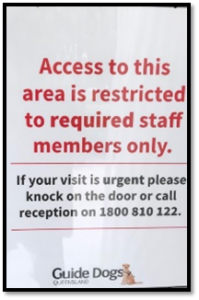
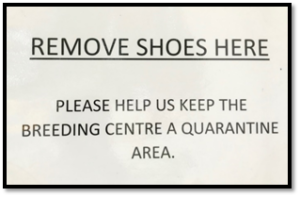
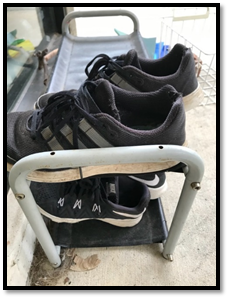
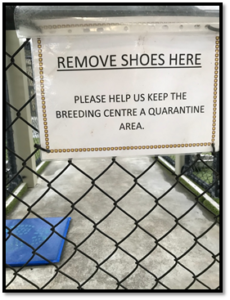 </center<
</center<Examples: Inside Breeding Centre
- Upon entering the breeding or kennel area either leave outdoor shoes outside building or cover outside shoes with disposable plastic overshoe booties.
- Proceed to hand washing station: Wash hands either with foam or gel and wash off with water. Alternatively, use a sanitising hand wash.

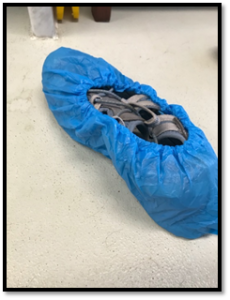

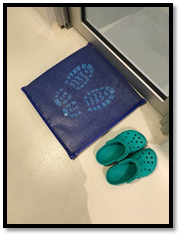
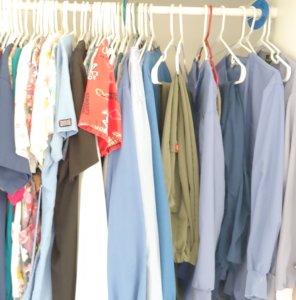
Hand washing
Hands are one of the principal ways that disease causing organisms are transmitted. Hand washing is probably the most important procedure for reducing the number of pathogens. Antimicrobial containing products will kill or inhibit the growth of microorganisms.
Hand hygiene is the responsibility of all individuals working with animals. Effective hand hygiene kills or removes microorganisms on the skin while maintaining hand health and skin integrity (i.e. prevents chapping and cracking of skin). Sterilization of the hands is not the goal of routine hand hygiene – the objective is to reduce the number of microorganisms on the hands, particularly the number of microorganisms that are part of the transient microflora of the skin, as these include the majority of opportunistic pathogens on the hands. These transient microbes may be picked up by contact with a patient, another person, contaminated equipment, or the environment.
There are two methods of removing/killing microorganisms on hands: washing with soap and running water or using an alcohol-based hand sanitizer. Hand hygiene is the single most important way to prevent infections in the breeding/kennel setting.
- HAND WASHING
Most transient bacteria present on the hands are removed during the mechanical action of washing, rinsing and drying hands. Hand washing with soap and running water must be performed when entering, during and upon leaving the working environment.
If running water is not available, use moistened towelettes to remove all visible dirt and debris, followed by an alcohol-based hand rub. Either liquid or foam soap should be used and dispensed in a pump dispenser.
Soap containers should not be refilled without being disinfected, since there is a risk of contaminated antibacterial soaps, where invasive procedures are performed. Antibacterial soaps should be used before entering a high-risk area, such as the den when the brood is whelping.
- ALCOHOL HAND SANITISER
There are also alcohol hand sanitiser bottles that need to be positioned around the building for all personnel to use intermittently throughout the day. Bar soaps are not acceptable because of the potential for transmission of pathogens from one person to another.
Wash hands before and after leaving a den or after contact with any body fluids, potentially infectious or contaminated material; before and after contact with items in den environment; before performing invasive procedures; before eating food and after personal body functions, such as using the toilet or blowing one’s nose
Recommended Technique for Hand Washing
- Remove all hand and arm jewellery.
- Wet hands with warm (not hot) water. Hot water is hard on the skin and will lead to dryness and additional skin damage.
- Apply liquid or foam soap.
- Vigorously lather all surfaces of hands for a minimum of 20 seconds. This is the minimum amount of time required for mechanical removal of transient bacteria.
- Pay attention to fingertips, between fingers, backs of the hands and base of the thumbs and under the nails. These are the most missed areas. A simple way many people time their hand washing is by singing “Happy Birthday”.
- Using a rubbing motion, thoroughly rinse soap from hands under warm running water. Residual soap can lead to dryness and cracking of skin.
- Dry hands thoroughly by blotting hands gently with a paper towel. Rubbing vigorously with paper towels can damage the skin.
- Turn off taps with paper towel to avoid recontamination of your hands.
NOTE: If air hand dryers are used, hands-free taps are necessary, as turning taps off without using paper towel as described will result in recontamination of hands after washing. It is recommended that jewellery not be worn on the hands during working hours as it is difficult to wash hands adequately, (rings can be kept on a neck chain in these circumstances). Short-sleeved clothing or sleeves to the elbow at maximum is recommended to facilitate adequate handwashing.
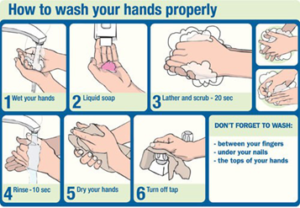
Position similar type posters at hand washing stations
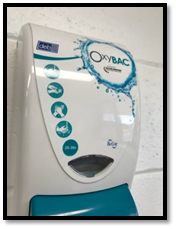
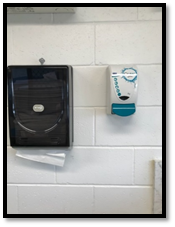
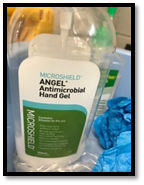
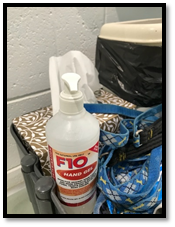
Cleaning Protocols - Prevention & Control
Protocols must be in place for all hygiene measures that minimise the risk of animal to animal transmission of disease.
Disinfecting floors and surfaces as well as any equipment/materials used daily will help to reduce the load of pathogens plus reduce the risk of disease.
Date | Completed by: | BASIC EVERYDAY CLEANING OF PENS PROTOCOL |
/ / | __________ | Dogs in season: Scrub with GP4 |
/ / | __________ | Gerni or hose out |
/ / | __________ | Mop with S3 (use allocated buckets for each pen) |
/ / | __________ | Towel dry |
- Cleaning involves the removal of visible debris from surfaces with soap or detergent.
- Disinfection involves the application of a chemical to kill microbes that cannot be removed by cleaning.
- Ensure all areas are well ventilated during cleaning & disinfecting and disposable gloves are worn.
- First clean the surface by removing dried-on or sticky debris from surfaces using a cloth/paper towel and a kennel disinfectant (use correct dilution rates).
- Follow above by cleaning using a higher-grade disinfectant (e.g. Virkon S).
- Floor surfaces should be mopped using either a kennel disinfectant or a higher-grade disinfectant (Virkon S).
- Replace mop heads regularly and clean and disinfect mops are each use.
- Always apply cleaners and disinfectants according to the product label, paying attention to dilution rates and required contact time.
Reminder: Cleaning and disinfectant chemicals and materials must be chosen based on their suitability, safety and effectiveness and must be used in accordance with the manufacturer’s instructions.
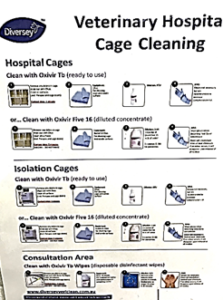
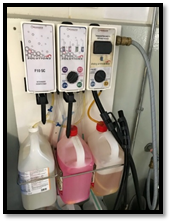
Pictured is a veterinary hospital cage cleaning protocol chart, and an example of a chemical storage room with multiple different cleaning chemicals.
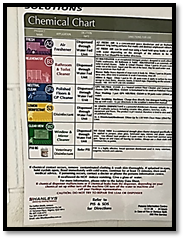
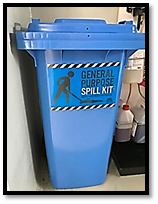
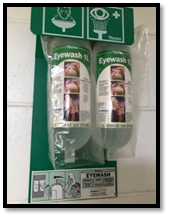
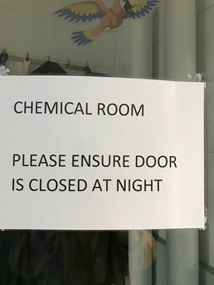
Signage, labelling and instructions are important to meet health and safety regulations.
References and Helpful Material
- www.vin.com
- https://www.hha.org.au/audits/audit-tools/other-audits
- http://www.oasishhi.com/oasis-blog/its-national-hand-washing-awareness-week
- Australian Veterinary Association Policy for Infection Control’ and ‘Code of Practice for Management of Hygiene and Infection Control’
- ‘Infection Prevention and Control Best Practices for Small Animal Veterinary Clinics’ developed by the Canadian Committee on Antibiotic Resistance (2008)
- Government Departments relevant to Biosecurity Protocols
